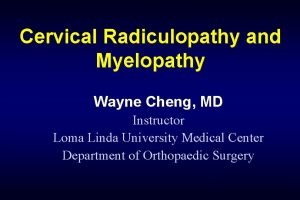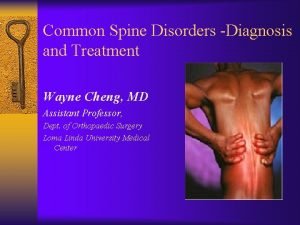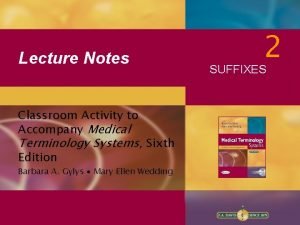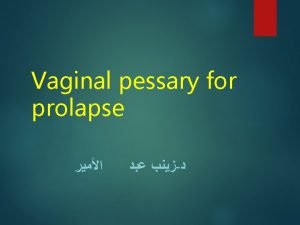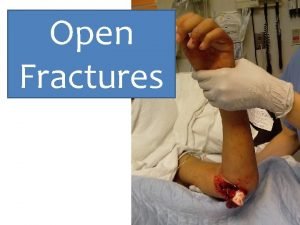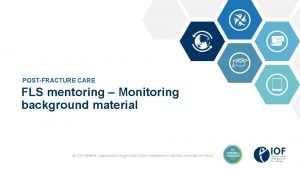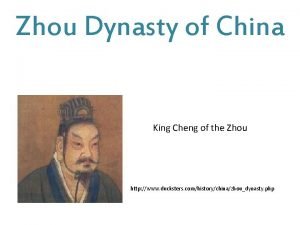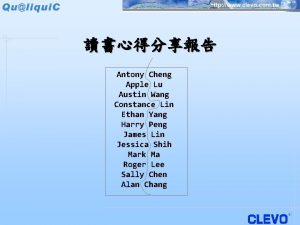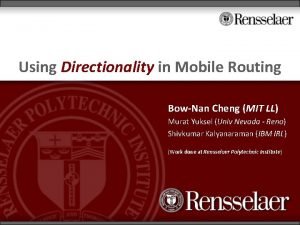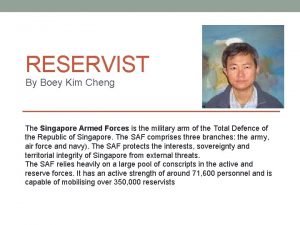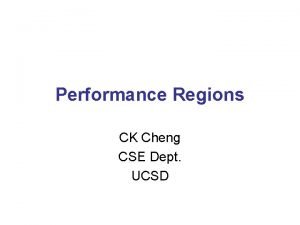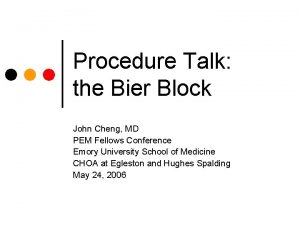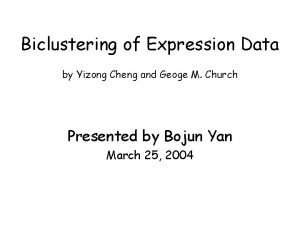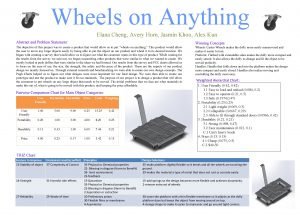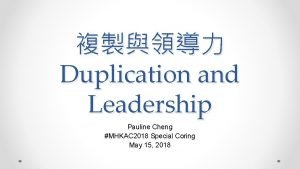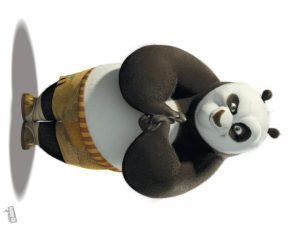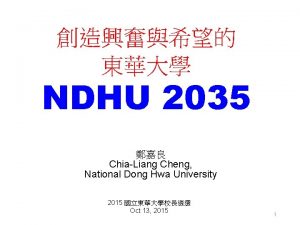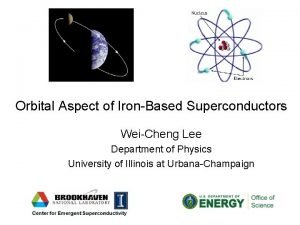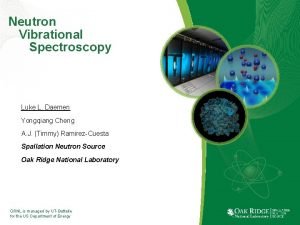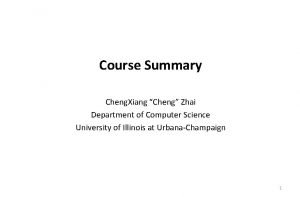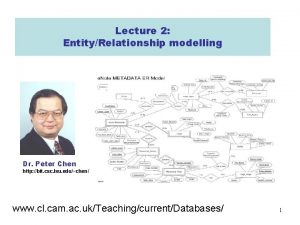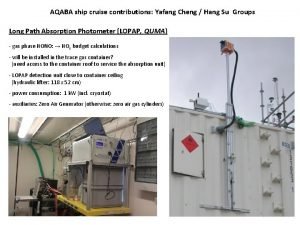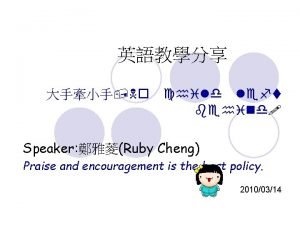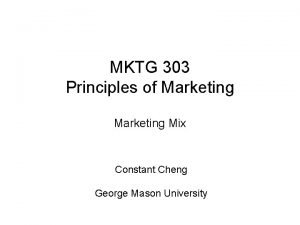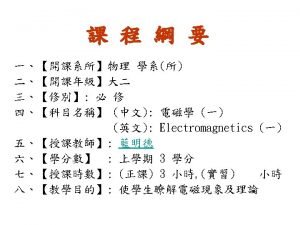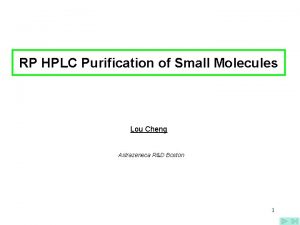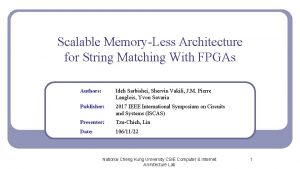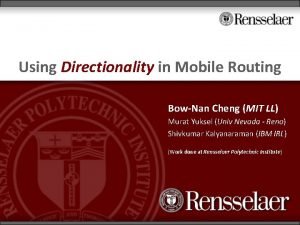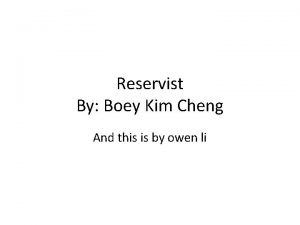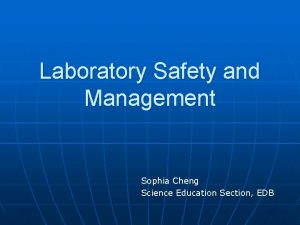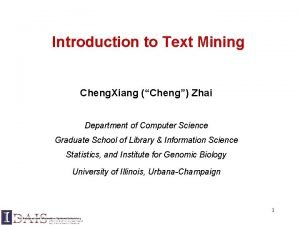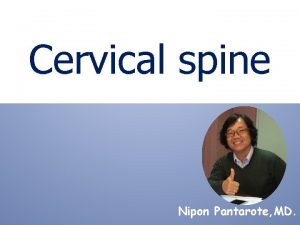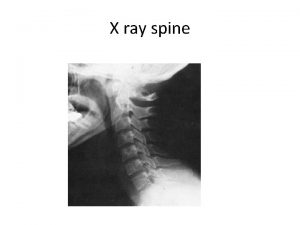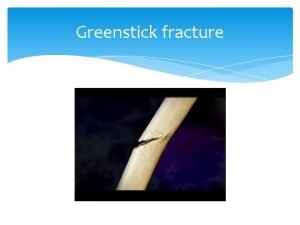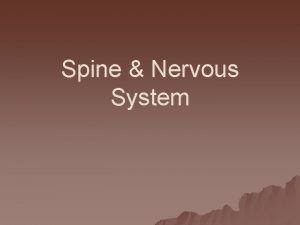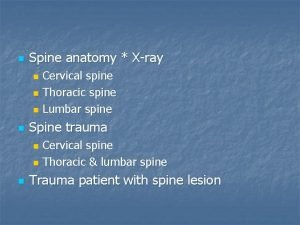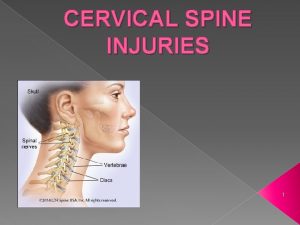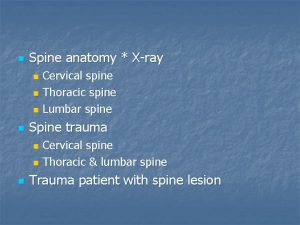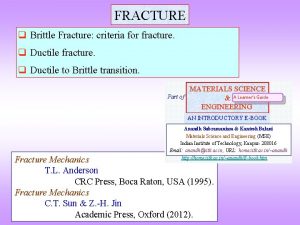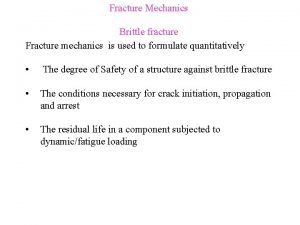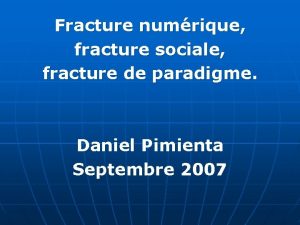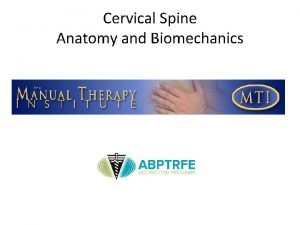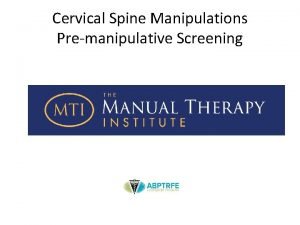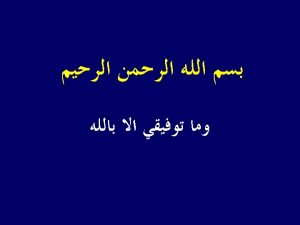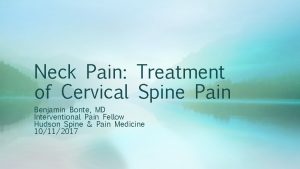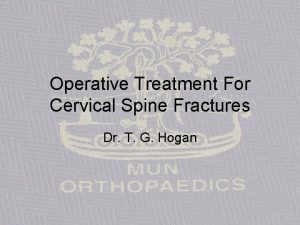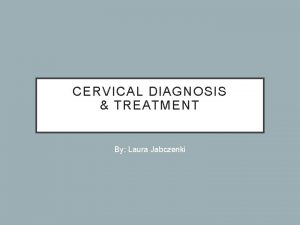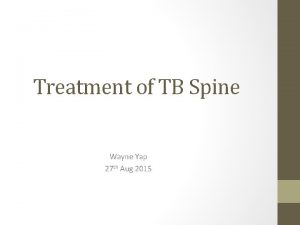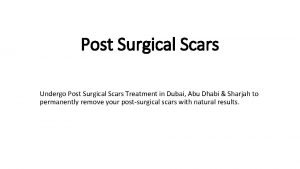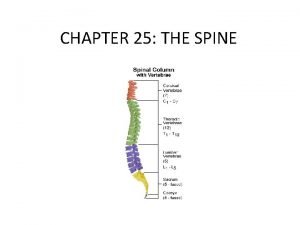Surgical Treatment for Cervical Spine Fracture Wayne Cheng


















































- Slides: 50

Surgical Treatment for Cervical Spine Fracture Wayne Cheng, MD Head, spine service Department of Orthopaedic Surgery 1

Outline • Introduction • Anatomy • C 1 / C 2 fracture – Jefferson, – Hangman’s, – odontoid • Subaxial fracture – jumped facet, – tear drop • Special topic ( clearing C spine, steroid) 2

Rule #1 • Don’t miss a injury • Non-contigous f. X = 16% • 2007 Lekovic et al. – 20 cases of missed or delay diagnosis C spine injury – Avg 2. 9 million $. – None due to test ordered that’s miss read 3

Anatomy 5 layers of ligament – Anterior atlantooccipital membrane – Posterior atlantooccipital membrane – Occipitoatlantoaxial complex • Apical/alar ligaments • Cruciform ligaments • Tectoral membrane 4

Anatomy • Posterior occipitoatlantoaxial ligament complex – Tectorial membrane(PLL) – Cruciform ligament • Transverse ligament • Longitudinal fasicculi – Alar & Apical ligaments • Alar ligaments – 2 portions – Primary to axial rotation/side bending 5

Anatomy • Steel’s rule of thirds – Internal diameter of the ring of C 1 is 3 cm • 1/3 = odontoid • 1/3 = cord • 1/3 = space (compressible soft tissue) 6

Anatomy • C 1 -C 2 = 50% of total axial rotation of cervical spine • Occip – C 1 = 50% of Cervical Flex/ext. – (20 -30 deg. Of “nodding”) 7

Anatomy • Blood supply: – Vertebral A. – Carotid A. – Ascending A. penetrate C 2 at base of dens. • Dens is mostly surrounded by synovial cavity • Soft tissue interposition 8

Anatomy • Vertebral Artery – Safe zone (1. 5 cm from midline) • Greater occipital Nerve • Posterior rami of C 2 • Sensation to skin at the back of scalp 9

Odontoid Fractures Classification Anderson & D’Alonzo • Type I (5%) – Fx. Cephalad to transverse ligament. – Avulsion of tip via apical and alar ligaments – Rule out craniocervical distraction. – Usually stable. – symptomatic treatment. • Anderson, L. D. ; D’Alonzo, R. T. JBJS 56 A: 1663 -1674, 1974 10

Odontoid Fractures Classification • Type II (60%) – Fx. Through the base of odontoid – Nonunion Rate 32% (11– 100%) • Displacement – > 4 to 5 mm – >10 deg of angulations • Delay diagnosis > 2 wks • Intolerant of halo – >40 year old – Polytrauma – Head/cord injury 11

Odontoid Fractures Classification • Type III (30%) – Fx. through the body of C 2 – Nonunion rate (0 – 15%) – Mech: suggest flexion – Reduction followed by halo vest 12

Treatment of Type II Odontoid Fractures • Stable = Halo vest – Displacement < 4 mm, 10 deg. – Age <40 year old – Injury recognition < 2 weeks. • Unstable = primary surgical stabilization – Displacement > 4 mm, 10 deg. – Delay diagnosis > 2 wks. – Intolerant of halo • Older, polytrauma, head/cord injury. – Irreducible C 1 -2 fx. dislocation. 13

Surgical Treatment of Type II odontoid Fractures Direct anterior screw fixation – Acute transverse fx. (no comminution / oblique coronal pattern) – Reducible with closed reduction – Chest wall/neck size proportionate – Bone density adequate Posterior C 1 -2 fusion – Fx. Comminution / oblique coronal pattern – Irreducible odontoid fx. – Irreducible C 1 -2 fx dislocation 14

Anterior Odontoid Screw • Advantages: – Preservation C 1 -2 motion (50% rotation) – Early post op stability • Disadvantages: – Significant learning curve – Complication 15

Posterior C 1 -2 Fusion 16

Transarticular C 1 -2 screws • Unstable Jefferson Fracture • Poor halo vest tolerance • Polytrauma • Elderly, debilitated 17

Atlas Fractures • 10% of all cervical spine injuries. • 48% has additional fractures in the C-spine – #1 Dens fractures. – #2 Traumatic spondylolisthesis C 2 – #3 Lower cervical fractures. • Mechanism – axial loading (MVA, diving) 18

Atlas Fractures Classification 1. 2. 3. 4. 5. Posterior arch. Burst(Jefferson). Anterior Arch. Transverse process. Lateral Mass 19

Posterior Arch Fracture • Location – junction of lateral mass & post. arch. (thinnest bone) • Incident – 28% • Mech – hyperextension • Association – odontoid and hangman’s fx. 20

Burst Fracture (Jefferson’s) • Incident – Most common (33%) • 3 or 4 part fx. • Least neurologic injury. 21

Burst Fracture • (X + Y) > 6. 9 mm = Disruption of Transverse ligament. • Accessory ligaments spared – Apical/alar ligm. – Facet capsule – Ant/post long. Ligm. 22

Anterior Arch Fracture • Mech: In hyperextension injury, Longus colli avulse off the inferior portion of anterior tubercle of C 1. • Stable fracture. 23

Lateral Mass Fracture • Mech: axial loading + lateral compression • 2 part Fx: ant & post to lateral mass on one side. • 3 part fx: 3 rd fx line on contralateral post arch. • X-ray: asymmetrical lateral mass displacement 24

Treatment-Posterior arch fx. • Isolated posterior arch fx. : – collar • Post arch fx. + type I “hangman’s fx” – collar • Post arch fx. + type II dens fx. : – – Reduction by traction then halo vest Anterior dens screw + collar C 1 -2 arthrodesis with Transarticular screw Halo then delayed standard C 1 -2 fusion 25

Treatment – Jefferson & lateral Mass fractures • Nondisplaced: • Displacement > 7 mm 1. – Collar or halo 2. 3. • Displacement < 7 mm: – Halo • Axial traction (6 weeks), reduction confirmed by open mouth view. Halo vest (6 weeks) Flex/Ext view end of 3 month Immediate C 1 -2 fusion 1. reduction via traction 2. Transarticular screws 26

Treatment: Combined Injuries Jefferson/lateral mass + others • Stable Jefferson + stable dens – Halo vest • Stable Jefferson + “unstable dens” – Anterior dens screw with halo vest? – Halo then delayed C 12 fusion? • Unstable Jefferson + “unstable dens” – Halo traction? – C 1 -2 fusion with Transarticular screws? 27

Traumatic Spondylolisthesis Type I • X ray: – Almost no angulations – Translation < 3 mm – Fx line near vertical • Mech: – Hyperextension + axial load • Levine AM, Edwards CC: JBJS 67: 217 -226, 1985 28

Traumatic Spondylolisthesis Type IA • X ray: – Almost No Angulations – Anterior translation < 3 mm, but posterior lines up. – Fx. Line not clear on lateral view. • CT: – Fx one in body, extends to other side. – May traverse foramen for vertebral A. injury. • Mech: – Hyperextension + lateral bending 29

Traumatic Spondylolisthesis Type II • X-ray: – – Angulations > 10 deg. Translation > 3 mm Fx line near vertical Fx at antsup. Of C 3 • Mech: – Hyperextension then flexion injury • Disruption: – PLL, anulus, disc – Ant long. Lig. stripped but intact 30

Traumatic Spondylolisthesis Type IIA • X-ray: – Significant angulations but min. translation with widening of Post disc space, deformity worsen with distraction. – Fx. Line oblique • Mech: – Flexion-distraction • Disruption: – PLL, anulus, disc, – some rupture Ant long. Ligm. 31

Traumatic Spondylolisthesis Type III • X-ray – Type I fx. + facet injuries. • Mech: – Flex distraction then hyperextension 32

Treatment Type I & IA • Make sure obtain flexion/extension views to rule out type II injury. (especially for big shoulders) • Obtain CT for type IA • Collar for true type I and IA 33

Non-Surgical Treatment Type II • < 5 mm, < 10 deg – Halo vest • >5 mm, >10 deg – Reduction with distraction and slight extension – Traction (4 -6 weeks) – Halo vest (4 -6 weeks) – (Goal of reduction) • Reduce kyphosis to dec. hyperextension of lower levels • Reduce nonunion rate 34

Surgical Treatment type II • Pedicle screw • Anterior cervical fusion with plate? 35

Treatment Type IIA • Do not distract! • Apply vest under image to apply extension and compression. 36

Treatment Type III • (Usually can not close reduce. ) 1. Obtain MRI to r/o disc herniation 2. Posterior open reduction of facets 3. Fusion of C 2 -3 by wire/plates 37

Insufficiency of the Transverse Ligament • Incidence – Fifth decade • Mechanism – Forced flexion of the neck • Clinical Presentation – Usually fatal – Survivor have neurologic symptoms from normal to transient quadriparesis. – Symptoms worse with flexion of neck. 38

Insufficiency of the Transverse Ligament • Flex/ext views • If ADI > 3 mm – Disruption of transverse ligament • If ADI > 5 mm – Disruption of transverse ligament + accessory ligaments. 39

Treatment • Rupture of transverse Ligament: – (fail with non-surg. Tx) – C 1 -2 fusion • Gallie • Brooks • Magerl’s transarticular screw • Avulsion Fx: – Surgery vs. halo? 40

Atlantoaxial Rotatory Deformity • Incidence – Rare in adults • Cause – MVA • Mechanism – Flexion and rotation • Max. rotation – bilateral dislocation = 65 degree (intact transverse ligament) – Unilateral dislocation = 45 deg. (deficiency of transverse ligament) • Clinical Presentation (wide spectrum) – – Neck pain torticollis (cock-robin) Neural deficit Vertebral Artery Injury 41

Atlantoaxial Rotatory Deformity • Open-mouth radiograph – Increase width of C 1 lateral mass – Widening of joint space 42

Atlantoaxial Rotatory Deformity • Open-mouth radiograph – Wink sign • Gold standard – Dynamic CT. 43

Atlantoaxial Rotatory Deformity Type I • Incidence – Most common (47%) • Displacement – No anterior displacement • Pivot – Odontoid • Transverse ligament – Intact • Fielding JW, Hawkings: JBJS 59: 37, 1977 44

Atlantoaxial Rotatory Deformity Type II • Incidence (30%) – Second most common • Displacement – Anterior 3 -5 mm • Pivot – Intact lateral facet • Transverse ligament – Deficient • Accessory ligament – Intact • Fielding JW, Hawkings: JBJS 59: 37, 1977 45

Atlantoaxial Rotatory Deformity Type III • Displacement – Anterior > 5 mm • Sublaxation – Both lateral masses • Transverse ligament – Disrupted • Accessory Ligaments – Disrupted • Fielding JW, Hawkings: JBJS 59: 37, 1977 46

Atlantoaxial Rotatory Deformity Type IV • Displacement – Posterior • Cause – Deficient dens • Fielding JW, Hawkings: JBJS 59: 37, 1977 47

Atlantoaxial Rotatory Deformities - Treatment • Look for etiology • Traction – Start with 6. 8 Kg. – Increase 0. 5 to 0. 9 Kg every three days. – Maximum 9. 1 KG • Post reduction – Immobilization for 2 -3 months. – Flex/ext. x-ray to check stability 48

Surgical Treatment • • Indications Spinal instability Neural involvement Fail to achieve reduction Fail to maintain reduction Methods • Gallie • Brooks-Jenkins • Transarticular screws 49

Thank you 50
 Myelopathy wayne
Myelopathy wayne Wayne cheng loma linda
Wayne cheng loma linda Reflexology spine
Reflexology spine Cervical myelopathy wayne
Cervical myelopathy wayne The suffix iatry means
The suffix iatry means Vaginal pessary
Vaginal pessary Cup and cone fracture ductile or brittle
Cup and cone fracture ductile or brittle Open fracture treatment
Open fracture treatment Fracture mentoring
Fracture mentoring Fracture treatment mentoring
Fracture treatment mentoring King cheng of zhou
King cheng of zhou Thanh phách
Thanh phách Antony cheng
Antony cheng Xiang cheng mit
Xiang cheng mit Boey kim cheng
Boey kim cheng Ck cheng ucsd
Ck cheng ucsd Judy cheng hopkins
Judy cheng hopkins Bier block
Bier block Cheng xiang zhai
Cheng xiang zhai Yizong cheng
Yizong cheng Nitra wheels
Nitra wheels Pauline cheng
Pauline cheng Cheng xiang zhai
Cheng xiang zhai Cheng kung fu panda
Cheng kung fu panda Chia liang cheng
Chia liang cheng Wei cheng lee
Wei cheng lee Yongqiang cheng
Yongqiang cheng Cheng zhai
Cheng zhai Peter chen er model
Peter chen er model Cheng ruize
Cheng ruize The planners boey kim cheng text
The planners boey kim cheng text Ruby cheng
Ruby cheng Chung-kuan cheng
Chung-kuan cheng Cheng xiang zhai
Cheng xiang zhai Cheng, constant
Cheng, constant Ismael herrera
Ismael herrera Sega cheng
Sega cheng David cheng electromagnetics
David cheng electromagnetics Cheng-few lee
Cheng-few lee Lou cheng
Lou cheng Cheng
Cheng Xiang cheng mit
Xiang cheng mit Cheng xiang zhai
Cheng xiang zhai Boey kim cheng disappeared
Boey kim cheng disappeared Sophia cheng accident
Sophia cheng accident Cheng xiang zhai
Cheng xiang zhai Plagg i rom
Plagg i rom Personlig tidbok för yrkesförare
Personlig tidbok för yrkesförare Orubbliga rättigheter
Orubbliga rättigheter Fspos vägledning för kontinuitetshantering
Fspos vägledning för kontinuitetshantering Ministerstyre för och nackdelar
Ministerstyre för och nackdelar
